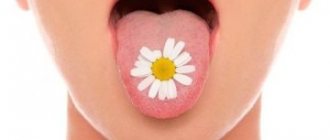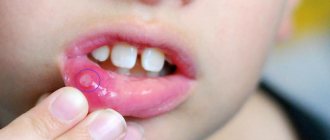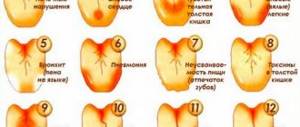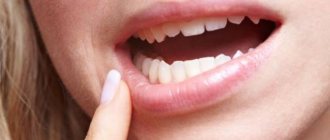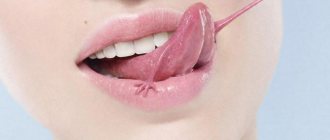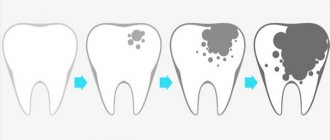What is stomatitis?
Stomatitis, which means “mouth” in ancient Greek, is the most common name for a group of diseases of the oral mucosa. The disease should not be confused with glossitis (damage to the tongue), cheilitis (damage to the lips) and palatinitis (damage to the palate). Stomatitis is not contagious, but almost every person has directly or indirectly encountered one or another type of the disease. Once you have been ill, the chance of recurrence of the disease is very high.
Correctly diagnosing stomatitis is difficult. The doctor often assesses the situation only visually - in medicine there are no special tests for this disease. The difficulty of diagnosing stomatitis also lies in the fact that it can be a symptom of more serious diseases.
Systemic pharmacological treatment –
Systemic therapy includes 3 types of drugs - antihistamines, glucocorticoids and immunomodulators. Antihistamines can and should be prescribed to absolutely all patients with aphthous stomatitis (without exception), the cause of which has not been precisely established. As for the drugs of the other 2 groups, they are the second line of defense, after which there are essentially no other treatment options.
1) Antihistamines –
Antihistamines will be an excellent addition to local therapy even for mild cases of aphthous stomatitis. The fact is that aphthous stomatitis can often be caused by unidentified food allergens (or components of hygiene products, for example, parabens). Therefore, it makes sense to start taking 2nd generation antihistamines orally for a course of 7-10 days.
Modern antihistamines are well tolerated and do not have significant side effects, therefore, given the difficulty of identifying the true cause of ulceration, you can start taking them from the first day of the disease, or even better - in the prodromal period, when ulcers have not yet formed, but the patient can already feel at the site of their future occurrence there is a slight burning or itching.
Table No. 1 (examples of 2nd generation antihistamines)
Means for nonspecific hyposensitization - for moderate and severe forms of aphthous stomatitis, when we need to quickly reduce the patient's body's sensitivity to allergens - in this case, the use of drugs for nonspecific hyposensitization is indicated. For example, these could be subcutaneous injections of histoglobulin - 2 ml 2 times a week with an interval of 2-3 days (a total of 10-12 injections per course). Or we can prescribe intravenously - a 30% solution of sodium thiosulfate, 10 ml daily, for a total of 6-8 injections for a course. These are all prescription drugs!
2) Systemic glucocorticoids –
These drugs are a second line of defense and are a lifesaver for patients with acute severe outbreaks of canker sores, but these drugs can only be used as directed by a doctor. Typically, prednisolone tablets are used in adults at an initial dose of 25 mg/day for the first 7 days (followed by a gradual dose reduction). The total duration of therapy is usually 15 days, but in severe cases it can even reach 1-2 months.
However, in a clinical study by Pakfetrat et al. (source) – good results of treatment with prednisolone were achieved when used at a dosage of only 5 mg/day. Prednisolone is an extremely effective drug for the treatment of severe forms of aphthous stomatitis, but its dosage must be selected individually for each patient (taking into account the severity and severity of the disease, as well as the patient’s health condition). Be aware that prednisone may cause long-term side effects.
The search for alternative, safer drugs made it possible to find that the drug "Montelukast" (usually used as an anti-asthmatic drug) - at a dose of 10 mg per day, like prednisolone, reduced the number of lesions, relieved pain and accelerated the healing of ulcers, but at the same time it caused significantly fewer side effects (clinical study - Femiano et al.). It is important that Montelukast can be used even when systemic glucocorticoids are contraindicated.
3) Immunomodulators –
Immunomodulators are also a second line of defense, as are glucocorticoids. Their use is especially indicated in patients who are diagnosed with chronic recurrent aphthous stomatitis (with frequent relapses and an aggressive course of the disease). Among the immunomodulators, amlexann, colchicine 1-2 mg/day, cyclosporine, cyclophosphamide, dapsone, methotrexate, and thalidomide at a dose of 50-100 mg/day can be used.
When using thalidomide, 85% of patients experience complete remission of severe lesions within the first 14 days, but this drug has very strong side effects. Another immunomodulator is the drug Levamisole, which restores normal phagocytic activity among macrophages and neutrophils and modulates T-lymphocyte-mediated immunity. The use of levamisole significantly reduces the duration of outbreaks of aphthous stomatitis, and it is prescribed - 150 mg 3 times a week (for 6 months).
Levamisole is safer than other immunosuppressive drugs, although side effects including nausea, hyperosmia, dysgesia and agranulocytosis have also been reported. It should be noted that treatment with immunomodulators and glucocorticoids is essentially palliative, because None of the systemic drugs can provide permanent remission of the disease.
Causes of stomatitis
The mechanism of stomatitis, unfortunately, has not yet been fully identified, so there are many causes of the disease:
- microorganisms that cause infection, acting directly on the oral mucosa;
- diseases of the gastrointestinal tract;
- diseases of the cardiovascular system;
- general weakening of the immune system;
- avitaminosis;
- metabolic disorders;
- nervous disorders;
- malignant tumors;
- hormonal fluctuations;
- various injuries in the form of abrasions of the oral mucosa;
- anemia;
- heredity.
Among the causes of stomatitis there are also local factors. Elementary lack of oral hygiene, caries, dysbacteriosis, poorly made or poorly installed dentures, the consequences of using medications, nicotine and alcohol consumption, as well as allergic reactions to products. Of particular note is the use of toothpastes containing sodium lauryl sulfate. Various studies have proven that they provoke the occurrence of stomatitis and its exacerbation.
Symptoms of stomatitis
Light redness of the oral mucosa is the first symptom of stomatitis. Over time, they swell and a burning sensation appears. If treatment is not started at this stage, the redness is replaced by small oval or round ulcers, grayish or white, with a red halo and a film on top. Moreover, the tissue around them looks absolutely healthy. Mouth ulcers are very painful and make eating difficult. They appear on the inner surface of the cheeks and lips, under the tongue. In most cases, mild stomatitis manifests itself as one ulcer.
The appearance of several ulcers of larger size and depth, which sometimes merge into one, are signs of more severe forms of stomatitis. The appearance of ulcers is accompanied by fever, inflammation of the lymph nodes, general deterioration of health, headache, loss of appetite and constipation. Acute stomatitis is accompanied by severe pain in the mouth, which interferes with eating and speaking. In addition, there may be excessive salivation, a coating on the tongue, a bright red mouth, irritability, and vomiting after eating.
Symptoms of stomatitis on the tongue
In adults, stomatitis on the tongue begins acutely. A slight malaise appears, the temperature rises to subfebrile levels (37.1-38°C). Symptoms of acute intoxication (muscle pain in the arms and legs, headache, weakness) and a temperature above 38°C occur only with a herpetic infection.
A symptom of herpetic stomatitis is increased sensitivity of the tongue. A white or yellowish coating appears. Sometimes, instead, redness and thickening appear on the tongue, which turns into swelling.
After 1-2 days without treatment, stomatitis becomes complicated by ulcers. They have smooth edges and a clear halo. Swelling of the tongue and signs of epithelial detachment are noticeable. The pain intensifies so much that it becomes too painful for the patient to chew food and even talk.
Additional symptoms of stomatitis:
- increased bleeding of gums;
- unpleasant odor;
- excessive or insufficient salivation.
Types of stomatitis
There are many types of oral stomatitis.
Catarrhal stomatitis
The most common type of stomatitis. With this unpleasant disease, the oral mucosa becomes swollen, painful, hyperemic, and may be covered with a white or yellow coating. There is an increased secretion of saliva. All this may be accompanied by bleeding gums and bad breath. The causes are local factors: poor hygiene, caries, tartar, oral candidiasis. Catarrhal stomatitis also occurs as a result of diseases of the gastrointestinal tract and worms.
Ulcerative stomatitis
A more severe disease than catarrhal disease. It can develop independently or be an advanced form of catarrhal stomatitis. Most often it develops in people suffering from gastric ulcers or chronic enteritis, diseases of the cardiovascular system and blood, infections and poisoning. With ulcerative stomatitis, the entire thickness of the mucous membrane is affected, there is an increase in temperature to 37.5 0C, weakness, headache, enlargement and tenderness of the lymph nodes. Eating is accompanied by severe pain.
Aphthous stomatitis
Causes of the disease: gastrointestinal tract, allergic reactions, viral infections, rheumatism, and heredity. Aphthous stomatitis has symptoms:
- the appearance on the oral mucosa of single or multiple aphthae - small ulcers (3 - 5 millimeters) of gray-white color with a narrow red rim;
- bad feeling;
- increased temperature and pain of ulcerative lesions.
The disease can have an acute form or occur chronically with periods of exacerbation and remission, the so-called chronic recurrent aphthous stomatitis.
Candidal stomatitis
It is a fungal disease that most often appears in young children (stomatitis in children) and the elderly. This type of stomatitis is caused by a fungus (usually the Candida genus) and develops mainly when the body’s immune forces decrease, as a result of long-term treatment with strong antibacterial drugs, as well as against the background of another chronic disease. Candidal stomatitis has the following symptoms:
- burning sensation in the mouth and larynx,
- white coating on the tongue and mouth,
- hyperemia and bleeding of the mucous membrane,
- bad taste in the mouth or loss of taste.
This type of stomatitis is considered contagious and can be transmitted both through household and sexual contact.
Herpetic or herpes stomatitis
Occurs in both adults and children. It is caused by the herpes simplex virus and can be acute or chronic. Symptoms of herpetic stomatitis:
- in mild cases, small blisters appear, resembling aphthae;
- the severe form is characterized by multiple rashes on the mucous membrane;
- swelling and inflammation of the lining of the oral cavity;
- increased salivation;
- general malaise;
- toxicosis;
- elevated temperature;
- enlarged lymph nodes;
- burning sensation and pain when eating.
The peculiarity of herpetic stomatitis is that the herpes virus remains in the body forever.
Allergic stomatitis also occurs; read more about the disease in the article.
Allergic stomatitis
It is an allergic disease that can occur in both adults and children. Its etiology is different: if in childhood the allergen is most often food products introduced into the child’s diet for the first time, then in adult patients the triggering mechanism for the pathological reaction may be weakening of the immune system due to the use of certain medications, rejection of dentures or advanced inflammatory processes in the oral cavity.
The characteristic signs of allergic stomatitis are:
- itching in the mouth, increasing after eating;
- severe swelling of the oral mucosa;
- secretion of a large amount of thick saliva;
- hyperthermia;
- unbearable pain;
- bad breath.
For the treatment of allergic stomatitis, in addition to visiting a dentist, consultation with an immunologist and an infectious disease specialist is recommended.
Treatment in adults
How to treat stomatitis in adults
After determining the type and cause, the doctor explains in detail how to treat stomatitis. There are no special medications to combat this disease. Basically, drugs are prescribed that destroy infection, relieve inflammation and accelerate the regeneration of damaged tissues.
Adults can use topical solutions that have an antimicrobial effect, for example:
- "Furacilin";
- "Chlorhexidine";
- hydrogen peroxide.
After treatment with an antiseptic solution, the affected mucosa is lubricated with dental gel, which has an anti-inflammatory and analgesic effect. The following drugs are suitable for adults:
- "Kamistad";
- "Metrogil-Denta".
In the initial stages, when the inflammatory process has not started and there are no complications, stomatitis is treated with soda, a medicinal herbal infusion based on the following herbs:
- chamomile;
- calendula;
- sage.
If pathological lesions cause severe pain, painkillers are used. For viral stomatitis, antiviral drugs are additionally prescribed. If the disease occurs as a result of an acute allergic reaction of the immune system, antihistamines are used. In case of candidiasis, the patient must take courses of local and systemic antifungal drugs, as well as immunostimulants. If aphthous or ulcerative stomatitis is diagnosed, the patient is prescribed local and general treatment aimed at stopping the inflammatory process and preventing the progression of the disease.
In addition to drug treatment, adults must adhere to other rules:
- Carefully monitor oral hygiene, using toothpastes, rinses and mucosal care products prescribed by your doctor.
- Follow a diet, avoid solid, hot, salty and spicy foods.
- Take vitamin and mineral complexes to support immunity.
- Cure dental diseases: caries, gum disease, tartar.
If the disease has entered a chronic stage, physiotherapeutic procedures will help prolong periods of remission and prevent complications, such as:
- percutaneous laser biostimulation of blood;
- helium-neon laser therapy;
- UV therapy.
How to treat stomatitis?
Any treatment for stomatitis begins with a professional hygienic cleaning procedure, during which tartar and soft plaque are removed. Almost any dental clinic in Moscow provides a similar service. Teeth affected by caries are treated. The mucous membrane is treated with antiseptic rinses. During the day, rinse the mouth with a warm solution of chamomile or calendula decoction. With timely treatment, catarrhal stomatitis disappears in 5–10 days. For ulcerative or aphthous stomatitis, local treatment is combined with general treatment. In addition to professional oral hygiene, antiseptic procedures are carried out in the clinic where stomatitis is treated.
If the presence of herpetic stomatitis is suspected, additional antiviral therapy is carried out. In case of oral candidiasis, treatment is prescribed with antifungal drugs. If the cause of stomatitis is some other disease, for example, the stomach or intestines, then it is necessary to begin to treat the root cause. During the treatment process, you should definitely follow a diet limiting spicy, hot, cold, sour and rough foods. A side effect of taking medications can be a green coating on the tongue.
Treatment at home
It is quite possible to cure stomatitis using home remedies. A decoction of chamomile or calendula is suitable as a pain reliever. Aloe and Kalanchoe juices help speed up the healing process. They need to treat ulcers 2-3 times a day.
Herbal solutions for rinsing should be brewed in boiling water. Take a spoonful of dry herbs for a glass of water. Be sure to infuse the solution for an hour and filter after cooling. You need to rinse with herbal infusion more than three times a day.
Traditional recipes for stomatitis:
- Hydrogen peroxide. Regular rinsing with this substance helps relieve pain. You need to dilute a teaspoon of peroxide in boiled water and gargle three times a day.
- Propolis. A tincture with an alcohol solution of propolis can relieve inflammation. You should dilute a spoonful of the solution in ½ glass of water. The effectiveness of this treatment can be increased by alternating with rinsing with peroxide.
- Aloe, Kalanchoe. Two more good remedies for inflammation. It is recommended to rinse your mouth with a solution of freshly squeezed juice from time to time or chew plant leaves.
- Garlic. This is a unique bactericidal agent that is good for stomatitis. You need to chop a few cloves of garlic and mix with fresh homemade sour cream. It is enough to keep the mixture on your tongue for 30 minutes several times a day.
- Potato. In the fight against stomatitis, you can use slices of raw potatoes or gruel.
- Carrot juice. Fresh carrot juice diluted with water is good as a gargle for tongue ulcers. It is necessary to carry out the procedure three times a day.
- Cabbage juice. Use in the same way as carrots.
- You can relieve pain from stomatitis with a solution of furatsilin or a weak solution of potassium permanganate.
Traditional medicine offers wound treatment products, decoctions, infusions and fresh plants. The advantage of the therapy is its naturalness, the absence of dyes and artificial additives. This is also a disadvantage, because the plant origin of natural ingredients can provoke allergies in the patient.
Herbal infusions
Many patients with stomatitis are helped by infusions and decoctions of medicinal herbs. In this case, the following plants are recommended:
- St. John's wort;
- anise;
- sea buckthorn;
- chamomile;
- sage;
- verbena;
- Eryngium flatifolia;
- horseradish;
- currant berries;
- calendula;
- bergenia;
- raspberries;
- Oak bark;
- Potentilla erecta;
- blackberry leaves.
All infusions can be prepared according to the same scheme: mix two teaspoons of herbs thoroughly, pour three glasses of boiling water, leave (preferably for several hours). You need to rinse your mouth with warm infusion. The course of herbal treatment is 10 days.
Recipes for stomatitis with herbs and available ingredients:
- Anise helps well with catarrhal and ulcerative lesions of the tongue. You need to steep a tablespoon of anise in a glass of boiling water for half an hour. Recommended for rinsing three times a day.
- An infusion of chamomile, calendula, verbena, bergenia and oak bark is also effective for stomatitis. You can only take those herbs that are available. The mixture must be poured with hot water and processed in a water bath for 15 minutes. Leave for 1-2 hours. This collection quickly copes with inflammation, relieves pain and disinfects the mouth.
- Safe methods for treating stomatitis at home include solutions with the juice of Kalanchoe, carrots and cabbage. These juices, diluted with water, are effective as a rub on ulcers and as a rinse throughout the mouth.
- For severe stomatitis, you can try stronger recipes. Ulcers can be lubricated with a mixture of novocaine (1 ampoule), vegetable oil (teaspoon), honey (teaspoon), and one egg white.
- Advanced stomatitis should be treated with a decoction of onion peels. For 100 g of husk you need to take 0.5 liters of water. Boil the broth for 15 minutes, then leave for 6-8 hours, strain. Then add boiled water equal to the amount evaporated. You need to drink the decoction warm three times a day.
Such treatment of stomatitis should be combined with the consumption of foods enriched with vitamins A, B, C, E.
Treatment with herbal infusions will be effective only with regular use. You should rinse your mouth three times a day with warm solutions. It is necessary to continue treatment even after the symptoms subside (a few more days), since the infection is not destroyed when the manifestations are eliminated.
Traditional recipes for stomatitis in children
Infants very often suffer from fungal stomatitis. The child becomes infected with infections through the pacifier and during feeding. If your baby has a whitish coating on the tongue and the inner surface of the cheeks, you need to take appropriate measures without delay. Sometimes, during an infection, the baby may refuse to breastfeed, which should attract the mother's attention.
There are very few safe remedies for stomatitis in children:
- You can use a soda solution: dissolve a dessert spoon of soda in a mug of water and lubricate pacifiers, toys and the mother's breast with it before feeding.
- Infants can be treated with a decoction of chamomile or calendula. Also, steam a dessert spoon of herbs in a glass of boiled water and leave for a couple of hours.
- For older children, rosehip or peach oil, flaxseed oil, and Kalanchoe juice are suitable. They can treat wounds.
- If the child already knows how to rinse his mouth properly, you can use a solution with protein: mix half a glass of water and egg white. You need to rinse three times a day.
- You can treat a 6-7 year old child for stomatitis using safe carrot or cabbage juice or potatoes.
- In severe cases, you can prepare a stronger remedy. You need to take a dessert spoon of birch leaves, two spoons of sage, three spoons of rose hips and a spoon of oregano. You are supposed to pour boiling water over everything and leave for a couple of hours. After settling, mix the solution with kombucha and leave for another three days. To achieve improvement in the child's condition, rinsing three times a day is required.
Possible complications
If stomatitis in the mouth is left untreated, it will certainly lead to negative consequences, from gum inflammation to tooth loss. That is why it is extremely important when treating stomatitis to strictly adhere to the recommendations given by your dentist. The list of major potential complications includes the following diseases.
- Chronic stomatitis.
Statistically, this is the most common complication. An untreated inflammatory process becomes chronic and recurrent, which means that an infectious focus will always be present in the body. - Appearance of scars.
A symptom such as bleeding gums can be a manifestation of many diseases, but with stomatitis, due to constant non-healing cracks in the oral cavity, scar tissue forms, which in the future may not allow the patient to open his mouth wide. - Laryngitis.
If the infection spreads up the respiratory tract, the patient's voice becomes hoarse and a cough appears. - Vision problems.
With advanced herpetic stomatitis, the target of damage becomes not only the gums, but also the mucous membranes of other organs. Most often, these are the eyes and genitals. - Loss of teeth.
The most dangerous complication of stomatitis. The main threat is the fact that the destructive process can last for many years and may not be noticeable to the patient at first. First, periodontal disease will develop - serious damage to periodontal tissue. And only then, as a consequence, the teeth will gradually become looser until they fall out.
When to go to the doctor
It is necessary to visit a doctor if there are any suspicious symptoms indicating the progression of stomatitis:
- ulceration of the mucous membrane in several places at the same time;
- temperature increase;
- the appearance of painful wounds and erosions, which is each time accompanied by an increase in temperature;
- swelling and hyperemia of the gums;
- unpleasant, putrid odor from the mouth.
Which doctor treats stomatitis?
Stomatitis in adults is treated by a dentist. If the disease is detected in a child, then he needs to be shown to a specialist who treats pediatric dental diseases.
The doctor conducts a thorough initial examination, gives a referral for a diagnostic examination, studies and interprets the test results, and then selects an individual treatment regimen that helps get rid of inflammation and accompanying symptoms as soon as possible.
Stomatitis and treatment at home
Treatment of stomatitis at home primarily involves the use of various herbal decoctions and infusions with antiseptic, anti-inflammatory and immunostimulating effects. For example, even doctors recommend rinsing with calendula - it has a strong antimicrobial and anti-inflammatory effect and promotes healing. Chamomile is an excellent antiseptic - it is one of the most popular remedies that is widely used in folk and official medicine.
Stomatitis is treated using folk remedies not only for rinsing, but also for oral administration. For example, rosehip decoction is a real storehouse of vitamins and other substances necessary for the human body. It improves immunity, prevents the development of inflammatory processes, and also helps destroy harmful bacteria. Despite the miraculous power of herbs, it should be remembered that candida and herpetic stomatitis will not be eliminated by such folk treatment, since fungi and viruses are not affected by antiseptic, anti-inflammatory and immune-modifying agents.
Prevention of stomatitis
The basis for the prevention of stomatitis is compliance with the rules of oral hygiene. Brushing your teeth twice a day with an ultrasonic brush and visiting a hygienist every six months are mandatory. It is important to monitor the general condition of your teeth. Wearing braces or dentures will require special attention, as they can injure the oral mucosa.
To prevent stomatitis, it is very important to be careful about your diet. Using special tests, it is recommended to identify and exclude foods that cause allergies from the diet. You should not eat foods that have a traumatic or irritating effect on the oral mucosa: crispy, salty, hot and spicy foods. Tomato and orange juices and alcohol are not recommended. The diet must be sufficiently balanced, since a lack of vitamins and microelements can cause an attack of the disease. Remember that stomatitis is always recurrent, that is, it occurs periodically during periods of general weakening of the body.
If you have had stomatitis at least once in your life, there will always be a risk of it occurring again. Therefore, prevention comes to the fore. Avoid bad habits, stick to a diet, try not to be nervous and, of course, maintain oral hygiene!
Aphthous stomatitis in children
The prevalence of stomatitis among children is an order of magnitude higher than among adults. This is determined by the fact that a child’s fragile body is weaker than an adult’s. Reduced immunological reactivity is a catalyst for the development of a chronic form of aphthous stomatitis, characterized by periodic exacerbations.
One of the main reasons for relapse of the disease in children is a complication of another oral disease. In addition, a sharp change in climate can also affect the occurrence of relapse.
Treatment of chronic aphthous stomatitis in children
Treatment of childhood aphthous stomatitis has a positive prognosis, however, it is worth understanding: if you start eliminating the causes of the disease in the early stages, you can achieve a greater effect and significantly reduce the child’s pain.
To identify the root cause of the disease, you need to contact a pediatrician, who can either independently diagnose or, for a more accurate diagnosis, give a referral to a dentist.
Typically, treatment of chronic aphthous stomatitis in children includes the use of ointments, adhesive pastes, and immunostimulating drugs: ·
- "Metrogil Denta"
- This is a fairly effective remedy in the form of an ointment, used in most cases in the treatment of aphthous stomatitis. Apply to damaged areas of the mouth twice a day after cleaning the mouth;
- "Solcoseryl"
– a paste that has a positive restorative effect on the epithelial tissues of the oral cavity. It is necessary to apply about 4-5 times a day and – necessarily – after eating;
- "Imudon"
is an anti-inflammatory agent that also has an anti-infectious effect. Use every few hours, but not more than 8 tablets per day.
Diet is important in treating the disease. Gentle nutrition and exclusion from the diet of solid foods, which can aggravate the course of the disease, is an important step in the fight against such an unpleasant disease.
Recommended to use:
- vegetable soups;
- fruit and vegetable puree;
- boiled meat;
- dairy products (in particular, natural yogurt and kefir have a positive effect on the body, providing an immunostimulating effect);
- Herb tea;
- natural juices from non-acidic fruits and berries;
In no case should food cause pain when consuming food and liquid. Therefore, a prerequisite for the diet is temperature: food and drinks should be warm - neither hot nor cold.
Treatment of stomatitis in children also includes banal rules that are not followed by everyone: in the morning and before bedtime, you need to thoroughly but gently clean your teeth with a toothbrush
with soft bristles. After eating, it is recommended to rinse your mouth with an herbal solution or warm boiled water.

